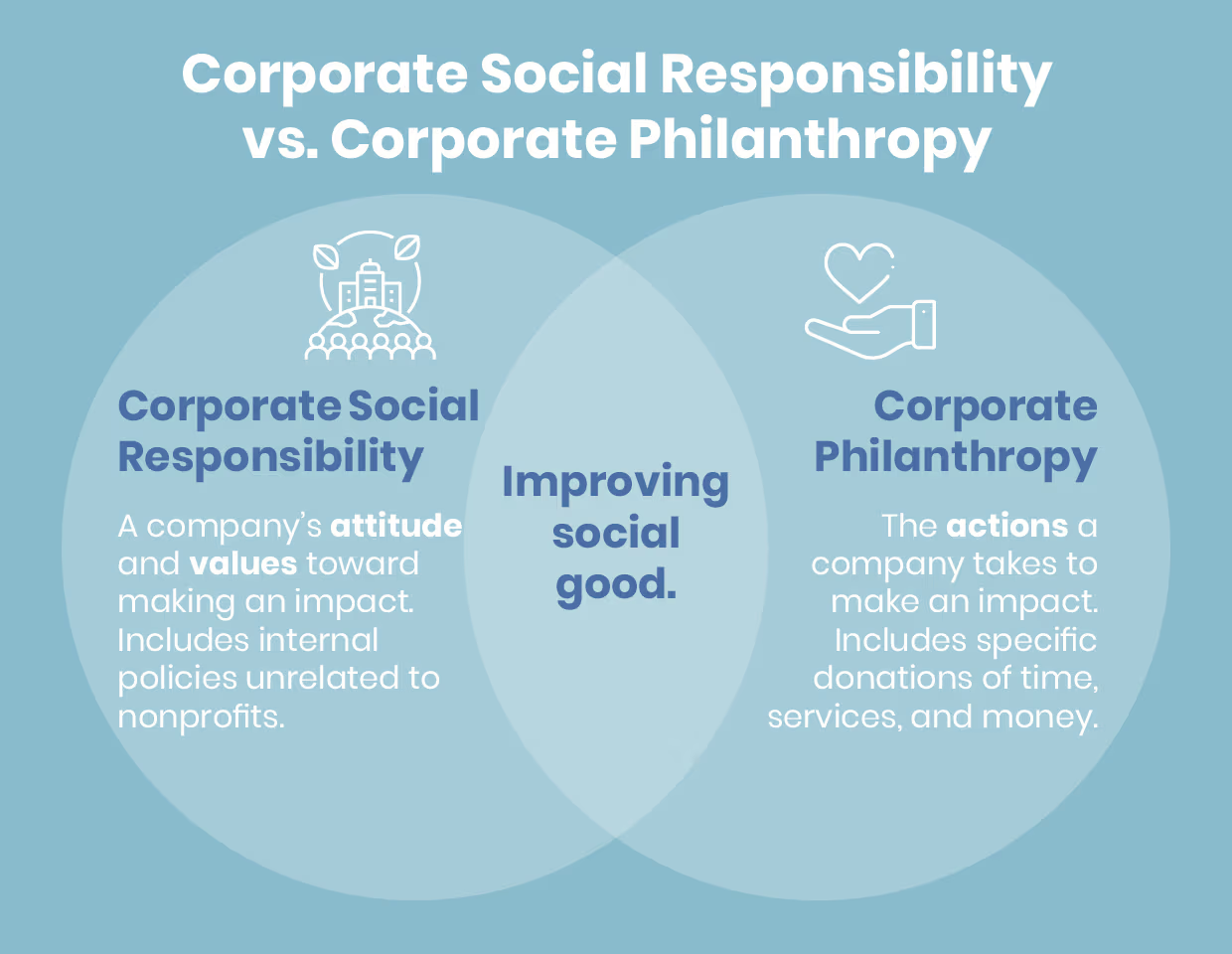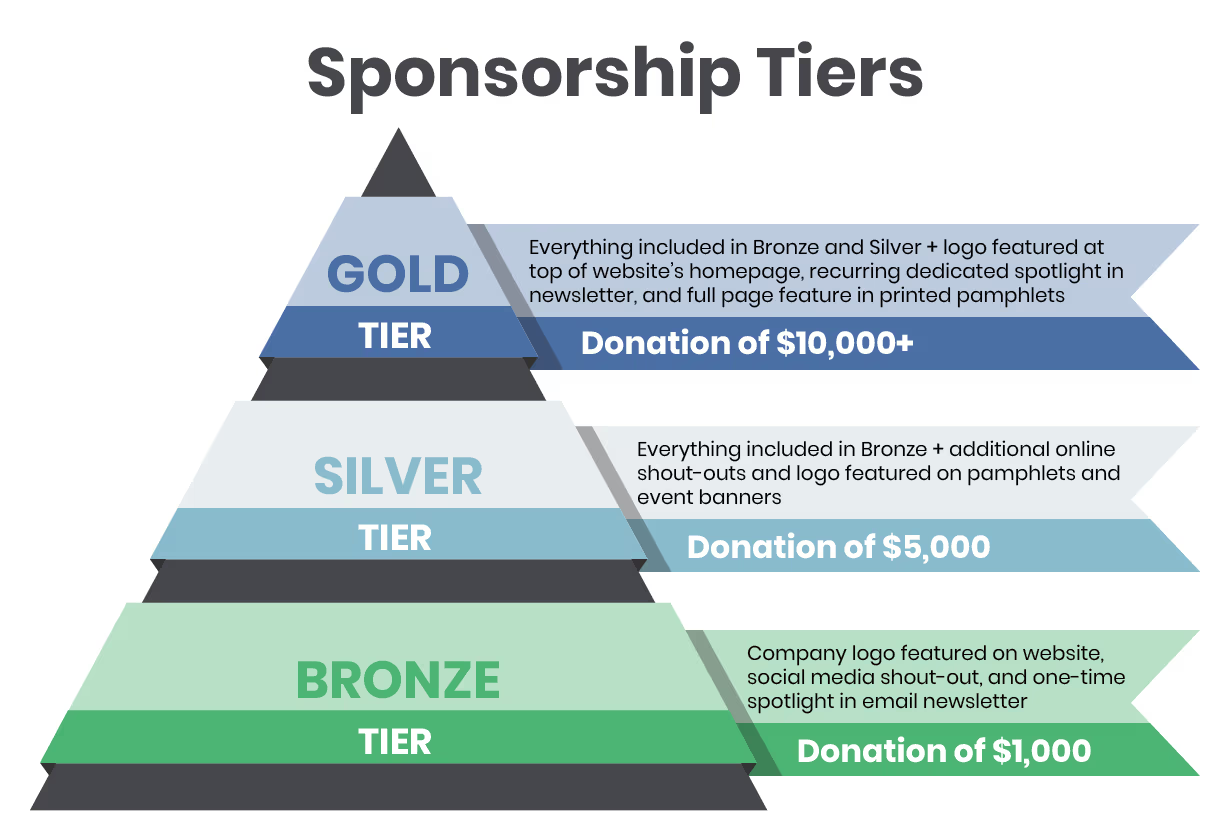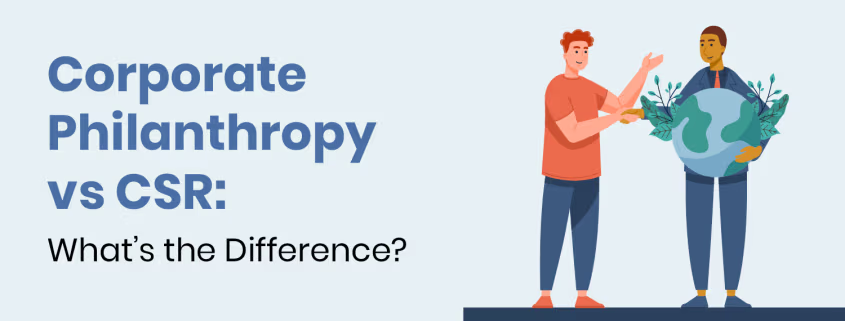Corporate Philanthropy vs CSR: What’s the Difference?
It’s in businesses’ best interest to promote social good for various reasons, chief among which is that 72% of consumers say they would recommend brands that support a good cause over those that don’t. Overall, reports from consumers and employees alike show that businesses can no longer be silent when it comes to issues that matter.
With this in mind, many business leaders look for ways to demonstrate their interest turn to corporate philanthropy initiatives Or should they turn to corporate social responsibility (CSR)? Or maybe both?
While trends show that companies of all sizes are becoming more active when it comes to social issues, the line between philanthropy and CSR is still murky for many business owners. Although some corporate leaders believe that the two terms are synonyms, the difference between corporate philanthropy and CSR is more than semantics.
For businesses that want to be more informed about corporate good, this guide will answer three essential questions:
- What is Corporate Philanthropy?
- What is Corporate Social Responsibility?
- What are Examples of Corporate Philanthropy and CSR?
Once you learn the difference between corporate philanthropy and CSR, remember you don’t need to choose just one. Many companies pursue both types of social good programs to be responsible corporate citizens.
What is Corporate Philanthropy?

Essentially, corporate philanthropy consists of the actions a business takes to support good causes. Most often, this takes the form of monetary donations to nonprofit organizations. For example, when corporations donate to nonprofits, host volunteer days, or provide grants, that’s corporate philanthropy.
Corporate philanthropy provides businesses with several benefits, including:
- Improved reputation. Businesses that publicly do good tend to have better reputations. When companies give to nonprofits, socially responsible customers will take notice. Similarly, employees want to work for employers they know are making a positive difference in the communities they and their families live in.
- Access to new audiences. Nonprofits are interested in courting corporate sponsors, and they are willing to offer businesses various benefits depending on the agreed-upon sponsorship package. Many of these packages involve marketing and promotion, providing corporations access to the nonprofit’s audience.
- Increased employee engagement. Many forms of corporate philanthropy can be pitched as part of your employee compensation package, improving your ability to attract and retain top talent. For example, you might provide volunteer grants, which are donations employers make to the nonprofits their employees volunteer with. Through this program, nonprofits receive funding and employees get to participate in social good.
Ultimately, if it involves your business taking an action that involves giving in some way, whether it’s donating or volunteering, that is considered corporate philanthropy.
What is Corporate Social Responsibility?
CSR refers to a company’s attitude towards being a responsible corporate citizen. As such, CSR is broader than corporate philanthropy. While it can include philanthropic actions, CSR also encompasses activities that have nothing to do with donating or nonprofits.
For example, a commercial fishing company might conduct CSR by taking steps to not disrupt fragile aquatic ecosystems, such as by ensuring their ships use environmentally friendly nets. These efforts are internal business practices that improve sustainability but are unrelated to supporting nonprofits dedicated to ocean conservation.
However, some CSR efforts can also involve philanthropy, such as if said fishing company decides to start a foundation dedicated to repopulating species that suffer from overfishing.
Essentially, the difference between CSR and corporate philanthropy is this: Corporate philanthropy refers to the actions businesses take that involve donating to nonprofit causes. CSR encompasses all of the company’s programs dedicated to being socially responsible, which includes internal business practices and philanthropic actions.
What are Examples of Corporate Philanthropy and CSR?
Now that you know the difference between corporate philanthropy and CSR, your business is ready to start thinking about your social good programs. Remember that corporate philanthropy and CSR are not an either/or choice, and in fact, many CSR programs include philanthropy as a component.
With that in mind, let’s look at a few popular program types many businesses have found success with:
Corporate Philanthropy: Employee Giving Programs
A reliable strategy for improving employee engagement and fulfilling your business’s philanthropic mission is employee giving programs. While employees want to work for businesses that donate part of their profits to nonprofits, many also appreciate having a more active role in how their employer gives. Employee giving programs grant them just that.
A few types of employee giving programs to consider include:
- Matching gifts. Matching gifts are popular among many top corporations, and it’s easy to see why. In this program, employers agree to match donations made to nonprofits by their employees. This provides employees with the freedom to donate to the causes they care about and feel supported by their employer, knowing the business they work for will also donate. Recently, more employers have been exploring matching gift auto-submission software, which allows employees to have their gift requests completed automatically for them. Here’s a video breaking down how this technology works:
- Payroll deductions. Some employees want to give more but just forget. With payroll deductions, they can agree to give once, and all their donations will be done automatically for them. Track donations through employee giving software so you can provide reports about what causes employees are giving and how much they’ve contributed in total.
- Grant stipends. Grant stipends are a method of corporate philanthropy wherein employees are awarded a set amount of funds to donate. With it, employees have the freedom to donate the funds to any organization they want.
The key to successful employee giving programs is communicating with your staff to understand what causes they want their donations to go to. You can limit what types of nonprofits they’ll support to focus your philanthropic efforts, but be aware that too many restrictions will lead to decreased participation.
CSR: Following Workers’ Rights Practices
Commitment to workers’ safety and well-being is a core tenet of many CSR programs, especially in industries that rely heavily on manual labor like construction and manufacturing. These types of CSR programs invest in the company’s employees, ensuring their long-term health and ability to complete work safely and without accident.
A few examples of workers’ rights practices include:
- Providing adequate compensation. Businesses should strive to offer their employees fair compensation. This involves providing wages that meet industry standards, negotiating in good faith with employees, and including other standard benefits, such as healthcare and childcare services.
- Using socially responsible supply lines. Companies that rely on supply chains should ensure their providers facilitate safe and fair work environments for employees.
- Abiding by safety standards. Minimize accidents by following proper safety guidelines as specified in your country. For U.S.-based companies, this means following OSHA’s safety standards. If you’re unsure what the safety policy for a specific process or practice is, OSHA likely has the information you’re looking for.
Outside of helping create a positive image of your company, strong workers’ rights practices will make recruiting easier, increase employee retention, and lead to a happier, more productive workforce.
Corporate Philanthropy: Sponsorships
Corporate sponsorships can take many forms, such as providing financial assistance, helping with cause marketing, or directly promoting a nonprofit through an employee giving program. No matter what form your support takes, the key to a successful sponsorship is finding a nonprofit that will be a reliable long-term partner.
While sponsorship deals vary, most partnerships between nonprofits and corporations of this kind follow these basic steps:
- Find nonprofits that align with your philanthropic values. Research nonprofits to find organizations with missions that are related to your company’s philanthropic values. In your search, try looking at local organizations first so you can support nonprofits dedicated to improving the community your consumers and employees live in.
- Negotiate sponsorship packages. Nonprofits seeking sponsorships usually provide multiple tiers for corporations to choose from. These will include varying levels of support in exchange for different benefits, such as promotion on the nonprofit’s website, social media shout-outs, featured logos on promotional materials for events, and so on. Here’s an example of what sponsorship tiers might look like:

- Determine the length of the sponsorship. How long do you intend to sponsor your nonprofit partner? Many sponsorships span multiple years. For example, you may fund an annual event every year. However, you may also decide to do limited-time sponsorships or reassess a sponsorship if the nonprofit shifts focus or undergoes a change in leadership.
When selecting nonprofits to sponsor or in the event a nonprofit approaches your business for a potential partnership, consider the audience you’ll be reaching. As part of the sponsorship, you’ll gain access to a nonprofit’s supporter base, so make sure to work with a nonprofit whose supporters are likely to be interested in your company’s products or services. For example, pet supplies stores often partner with animal shelters.
CSR: Implementing Sustainable Programs
The big buzzword in CSR right now is ESG, which stands for environmental, social, and governance. Let’s break down what these terms mean in practice and how they relate to sustainability:

- Environmental. What is your business’s environmental impact? Corporations need to be conscious about using excessive energy, extracting resources, and managing the pollution their products produce to be responsible corporate citizens. To mitigate environmental impact, businesses might adopt energy-efficient best practices or conduct environmental clean-ups for sites impacted by their operations.
- Social. What is your business’s impact on society? Social impact takes a look at workers’ rights, especially in a global context. For example, if a corporation requires exports from another country to make their products, what is the impact of that transaction? Businesses that practice CSR treat all their employees with respect by providing safe working conditions and adequate wages.
- Governance. Does your business conduct responsible governance? In ESG, the governance component essentially asks whether a business has the necessary internal bureaucratic structure and practices to be a responsible corporate citizen. This asks whether businesses responsibly pay taxes, conduct proper oversight, and follow regulations.
Businesses with strong ESG policies are received positively by employees who are happy to work for businesses they know are making socially and environmentally responsible decisions. Plus, consumers who want to support businesses with sustainable products and services will be more likely to give these companies their patronage.
Corporate Philanthropy: In-Kind Donations
Outside of monetary contributions, businesses can conduct philanthropy through in-kind donations. In-kind donations vary depending on the company offering them, but they primarily take two forms:
- Tangible goods. Does your business have a product that a nonprofit might need or benefit from having? If so, you can donate it. This might be a one-time in-kind gift, such as donating laptop computers to a school at the beginning of the year, or a recurring program, such as having a discounted price on a software subscription package for 501(c)(3) organizations.
- Professional services. Businesses can arrange volunteer days where their employees agree to lend a nonprofit organization their professional expertise. This can range from graphic designers creating new creative assets and nurses running medical tents at a 5K charity event to accountants checking a nonprofit’s bookkeeping and lawyers providing pro-bono services.
In-kind donations are tax deductible just the same as monetary gifts. Use your CSR software to track what your business and your employees have given to nonprofits and estimate the value of those services and products. The nonprofits you work with should also provide donation receipts, helping you to keep your financial bookkeeping organized.
CSR: Advocacy Support
Companies only have so much power to affect change, which is why some have taken to empowering other groups with their goals to create societal change. Supporting advocacy campaigns, either those hosted by nonprofits or groups formed specifically around advocacy, is similar to basic corporate philanthropy, wherein a corporation donates to a nonprofit. However, with advocacy support, the corporation has the explicit goal of influencing legislation to create change at a societal level.
Corporations looking to support advocacy groups should start by researching their local grassroots organizations. These groups are highly knowledgeable about the issues facing their community and have the time and dedication to create positive change. With your company providing resources such as monetary donations, supplies, and marketing support, advocacy groups can gain bigger platforms, increase supporters, and have their voices heard.
Consider what legislative policies your corporation wants to change and which advocacy groups have methods and a message you can support. For example, the Ben and Jerry’s Foundation specifically brands itself as a social justice-oriented organization. Therefore, its advocacy efforts focus on supporting groups focused on equality in its home state of Vermont.
Corporate Philanthropy vs CSR Concluded
Corporate philanthropy and CSR are closely intertwined concepts, and together, they enable corporations to make a positive difference in their communities. From improving internal practices to empowering nonprofits, both corporate philanthropy and CSR should be celebrated and prioritized.
Of course, this is just the tip of the iceberg when it comes to corporate philanthropy and CSR. To learn more before launching a program for either of these concepts, explore these resources:
- What Is Corporate Volunteerism? The Top Guide for Companies. Corporate volunteerism is a useful type of corporate philanthropy that enables employees to give back without dipping into their wallets. Learn how you can promote volunteerism in this guide.
- A Smart Guide to Unlocking the Power of CSR Software in 2023. Today, most CSR programs are backed by software. Discover what to look for in your CSR technology to choose a platform that enhances your programs.
- How to Unlock Corporate Giving: The Key to Boost Donations. Corporate philanthropy revolves around your business’s giving practices. Get your questions about corporate donations answered.






